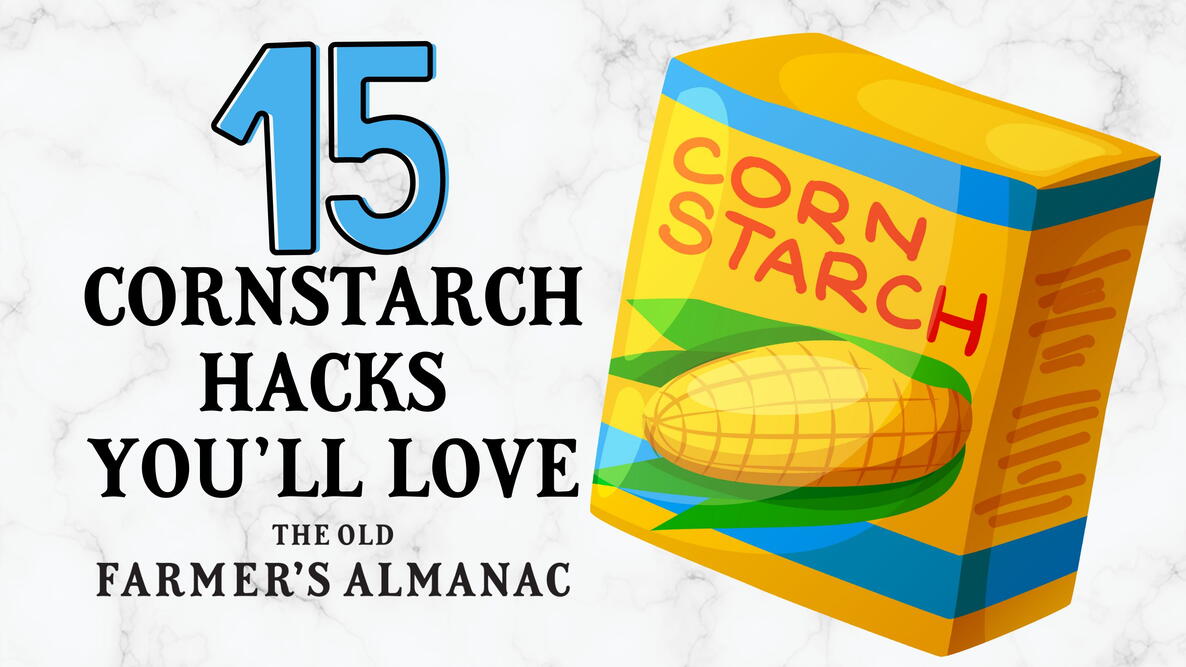You probably have a box of cornstarch sitting on a pantry shelf, waiting to thicken your next cream sauce or gravy. But did you know it can also serve as a cheap, nontoxic cleaning product that cuts grease, removes stains, scrubs, deodorizes, untangles, transforms into nontoxic finger paint, and more? Here’s a list of some practical ways to use cornstarch to save money and time!
In the kitchen, cornstarch is used as a thickener for sauces, soups, and gravies. See more about different cooking thickeners.
However, like a lot of pantry basics, you can turn to this staple for many other surprising uses! Here’s my list, but I’m sure there are more ways to use cornstarch and welcome your suggestions.
Cleaning and Stain Removal
Scrub Tubs
This works especially well for acrylic tubs and bathroom sinks. Mix a tablespoon of cornstarch with a cup of white vinegar in a glass measuring container. Mix well, then microwave for a couple of minutes. Funnel it into a spray bottle to which you’ve added a couple of tablespoons of liquid detergent.
Clean Glass
Cornstarch is a wonderful window cleaner! Add a tablespoon each of white vinegar and cornstarch to two cups of water. Funnel into a spray bottle and use on window or door glass. Your windows and glass will be streak-free!
Remove Stains
Dry or mixed into a thick paste with water, cornstarch can remove many kinds of stains on rugs, furniture, clothing, and other fabric items. Leave the paste on until it dries before brushing or vacuuming. A cornstarch paste even works to remove blood and grease stains. Repeat if a single application doesn’t completely remove the stain.
Polish Silver
Mix cornstarch with a little bit of water to bring out the natural shine in silver objects.
Freshen grubby fleece hats, mittens, stuffed animals
Pour a cup of cornstarch into a large paper bag, add dirty items, and shake well. Leave for a few hours if the items are stained. Remove items from the bag and brush or shake off excess cornstarch.
Loosen knots in shoelaces, hair, and dog fur
A knot in your shoelaces? Knots in hair or your dog’s fur? Sprinkle knots liberally with cornstarch, then pull and wiggle on the knot until the laces slide out. Sprinkle liberally on matted hair or dog fur and work it in down to the skin to help the matted fur untangle for easier brushing and clipping.
Deodorize Smelly Stuff
Dust the insides of smelly shoes or boots, liberally sprinkle over a dog’s coat (avoiding the face), and leave for a few minutes before shaking or brushing out.
Beauty, Personal Care, and Health
Soothe a Bite or Sting
A few drops of water in a spoon of cornstarch make a paste to spread on a fresh insect bite or sting.
Ease Sunburn Pain
While it’s better to focus on preventing sunburns in the first place, soothe the pain of one by applying a paste of cornstarch and water to the burned areas. Give it time to dry.
See more ways to soothe a sunburn.
Prevent Athlete’s Foot
Renowned for its absorbent qualities, cornstarch sprinkled between your toes and into your socks before putting them on will help keep feet dry and less susceptible to the fungi that cause athlete’s foot.
Dry-Shampoo Your Hair
Hair looking unkempt and greasy/stringy, but no time or motivation for a wash? Keep a small jar of cornstarch in your bathroom along with a large makeup brush or a small, flexible paintbrush. “Paint” or sprinkle the starch through your hair, working it in until it’s well distributed. Shake your head a bit, then brush the cornstarch out along with the grease and grime. Voilà! Smooth, shiny, and fluffed out, you’re ready to go.
Make a Quick Deodorant
You can find lots of recipes online for making homemade underarm deodorants, but why bother? Just use a large makeup brush to dust armpits with dry cornstarch. Stand on a towel so the starch that falls won’t get all over the floor. Pat treated the underarms with a soft cloth to remove excess.
Prevent/Treat Chafing
Many people experience chafing on the undersides of their arms, inner thighs, and nipple area, especially during vigorous exercise. Rubbing cornstarch over the areas that usually chafe will both lubricate them against chafing and soothe the irritation that may occur.
Fun and Practical Projects
Make a Seed Tape
Small vegetable seeds can be difficult to sow evenly across your seedbed, and trying to handle them can result in uneven spacing that wastes seed and increases the need for weeding. Buying pelleted seeds or seed tapes from a seed company can solve this problem, but with a little cornstarch you can make your own.
Start by making a cornstarch gel: Mix 1 cup of water with 1 tablespoon cornstarch in a saucepan, then stir gently and bring it to a boil for about 5 minutes. Once it thickens, allow it to cool completely. Next, place dabs of the gel onto strips of biodegradable paper at an appropriate spacing for your seeds, then press a seed or two into each dab before folding and pressing the edges of the paper together. Seems onerous, but it doesn’t take much time. It’ll save a lot of seed waste and weeding time.
Make Finger Paint
One fun family activity is to make nontoxic homemade finger paints using cornstarch, water, and food coloring.
Here’s a recipe: Add half a cup of cornstarch to two cups of water, whisk well, and boil until thick and gelatinous. Then separate into individual small containers such as repurposed yogurt cups, and add food coloring to reach a desired shade. Some folks add packets of Kool-Aid as the coloring agent.
By the way, potato or arrowroot starch works similarly to cornstarch!
Did you learn anything new? Another favorite all-purpose pantry staple is baking soda. See the many amazing uses for baking soda!
How do you use cornstarch around the house?


Comments